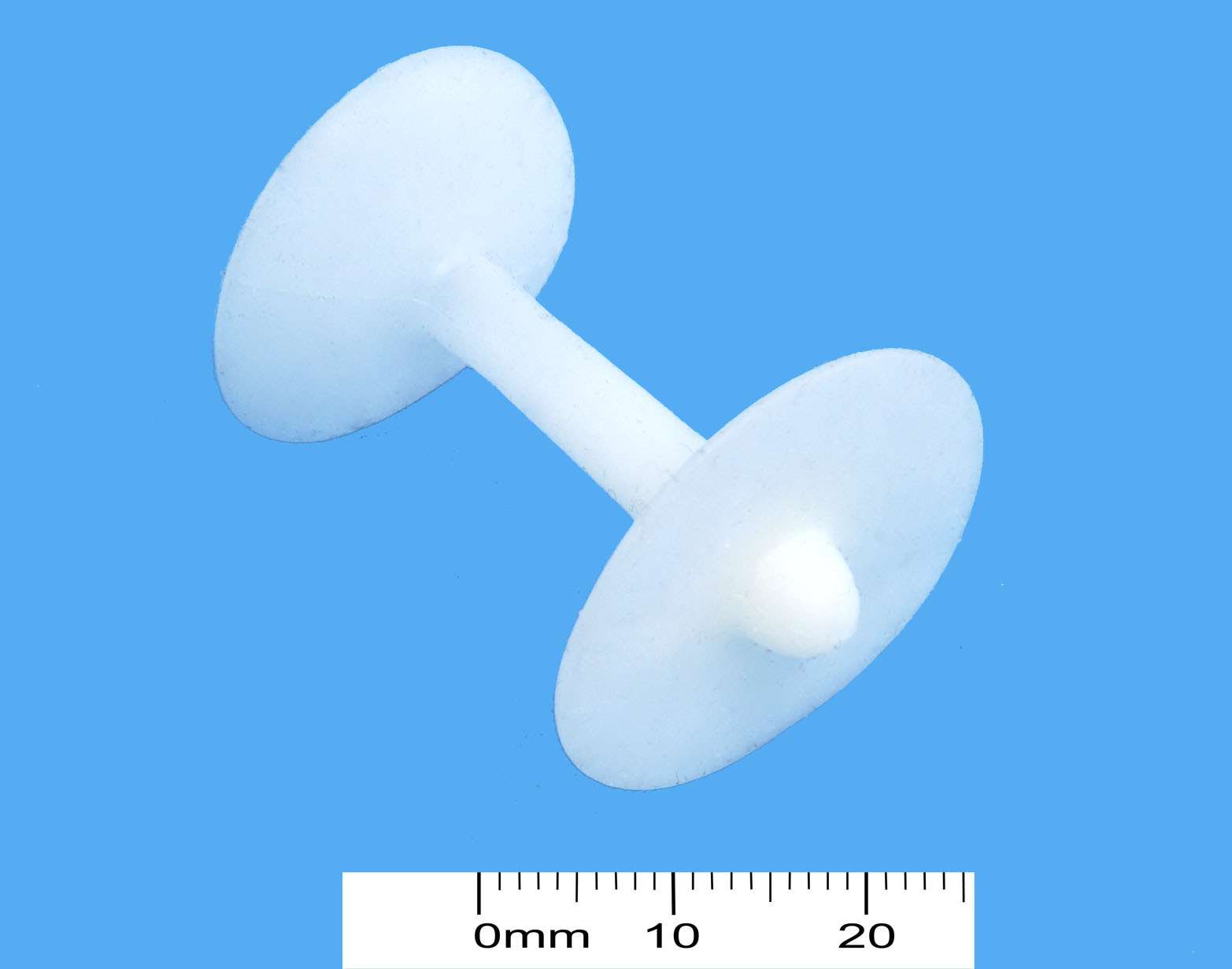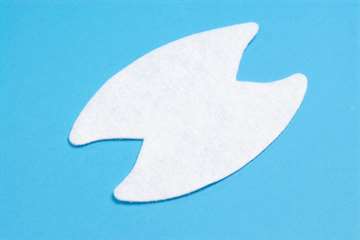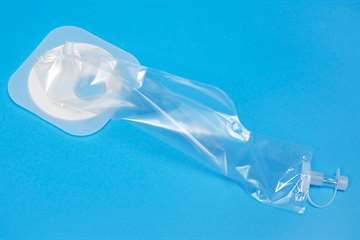Anal Inserts
Anal inserts are intended to work much like anal plugs but are made of soft silicone, with two disks connected by a soft spindle. They are inserted into the anus using a rigid applicator. The top (inner) disk is designed to sit inside the anus, forming a seal, while the outer (bottom) disk remains outside the anus to prevent the device from moving into the rectum.
There is limited research on the effectiveness and safety of these devices.12 In two trials, faecal leakage was reduced by at least half, with at least half of users reporting satisfaction with the device1314 and expressing a wish to continue using it.14 However, some women experienced discomfort, a feeling of needing to pass stool, and displacement of the insert into the rectum (although this was resolved with expulsion of the device during bowel movements).13 Amongst patients undergoing surgical treatment for ulcerative colitis, faecal leakage was reduced at night but was not significantly different during the day. Most were satisfied with using the device although a small number reported pain or bleeding when it was inserted.15
2
Anal insertWhere can I get anal inserts?
How you get anal inserts and where they are available varies according to local healthcare systems. Speak to your healthcare professional or contact the supplier using the link below.
Vaginal inserts
For women, a vaginal insert system placed in the same location as a tampon features an internal balloon, inflated and deflated by a discreet pump, to place pressure on the urethra and the rectum and prevent stool from passing. In trials, around 75% of women reported a 50% decrease in anal incontinence at three months, while amongst those who completed the trial, nearly all (94%) reported a 50% decrease at twelve months. There were no serious adverse effects and the device was generally considered comfortable, but around one third of women reported non-serious effects, such as vaginal or pelvic discomfort/irritation, lower urinary tract symptoms, or constipation.16
Faecal incontinence pads
5
Butterfly faecal padFaecal pads are designed specifically for bowel leakage and are shaped to fit between and around the buttocks. They are disposable and some have an internal cuff (raised elasticated area) designed to hold liquid or solid stool in place.
A disposable gauze dressing placed between the buttocks has been found to be acceptable for light bowel leakage where the stool usually remains between the buttocks and doesn’t soil underwear.17
| More likely to suit you if... |
Less likely to suit you if... |
- Actually, they suit most men and women
|
- You have skin problems in the anal area
|
Standard incontinence pads
Products designed specifically for bowel leakage are not widely available, so many people use pads that intended for bladder leakage instead, especially if they have both bladder and bowel leakage.
Pads vary in size and design so you may need to try different pads to find which works best for you. It is usually best to try smaller, more discreet pads first, and move to larger pads as necessary. You may find that only the larger pads for bladder leakage give sufficient cover for bowel leakage and that you have unnecessary bulk at the front of the pad.
Find out more about standard pads in Absorbent products for women and Absorbent products for men.
Where can I get faecal pads?
These products are available in supermarkets, online or direct from suppliers. Not all products are available in all parts of the world. Use the links below to find out how to get them where you are.
Faecal collection devices
Faecal collection devices are a group of devices that are intended to collect stool as it passes from the rectum. The stool is collected in a bag or pouch, which is periodically emptied.
7
Faecal collection deviceSeveral kinds of devices are available:
-
An external anal pouch consists of a flexible wafer that has an opening at its centre. One side of the wafer adheres to the skin around the anus and the other side is connected to a collection bag. The bag has a re-sealable port at the lower end through which faeces can be emptied without the need to remove the wafer from the skin. This port can also be connected to a larger gravity drainage bag. Some bags also have a flap to allow flatus to escape and prevent the bag filling with gas.
-
An intra anal stool bag is made of latex (20cm non extended, 26cm extended) that is inserted into the anus and an adhesive attachment (10cm in diameter) applied round the anus to secure it in position.18
-
Rectal tubes and catheters are inserted into the rectum to channel loose stool into a collection bag. A balloon near the tip of the catheter (inside the body) can be inflated once the catheter is in position to prevent leakage of stool around the catheter and to prevent the tube from coming out during a bowel movement.19 A new non-balloon-based system has a pliable diverter resembling the shape of a badminton shuttlecock that sits inside the rectum and is connected by a thin plastic sheath to an external collection bag. The diverter is folded into a disposable applicator used to insert it into the rectum and expands after the applicator is removed. In small pilot studies, around 90% of patients experienced only minor or no leakage from the system, and only a small number of minor adverse events related to device usage were observed. 2021
-
A rectal trumpet is made up of a naso-pharyngeal airway connected to a drainage bag. The flange (wide) end of the trumpet is inserted into the rectum.22 A trumpet is shorter than a rectal tube, so there is less chance of damaging the lining of the rectum. The other narrow end of the trumpet can be connected to a drainage bag.
Who are faecal collection devices good for?
They are used mainly by people who are very ill or confined to bed and need help with bowel management.1923242526 Faecal collection devices can help to prevent leaked stool coming into contact with the skin and causing skin damage. They can also be useful in allowing skin already damaged by incontinence-associated dermatitis or pressure ulcers to be treated. 27
Faecal collection devices are usually only suitable for loose stool - stool grades 6 or 7 on the Bristol Stool Chart. External anal pouches may be useful for firmer stool, but not when connected to an extra drainage bag. Rectal tubes and catheters work best with very liquid stool, which is most likely to flow without blocking the drainage hole.2628 They are often used in conjunction with bowel management programmes including daily saline irrigations through the rectal catheter to keep the stool liquid. It has been suggested that cutting the tip of the catheter off at an angle helps drain stool of a slightly thicker consistency.29
Faecal collection devices should not be used by people with intestinal mucosal disease, immunosuppression, gastrointestinal bleeding or bleeding tendencies, recent heart attacks or prostate surgery.2930
What about fitting?
Correct fitting and use are very important to give the best chance for all these devices to work and to minimise any risks associated with their use.
Applying an external anal pouch can be difficult, especially for people who have a small space or severe oedema between the anus and vagina or scrotum. It can be difficult to maintain the seal round the anus, especially if the skin in the area is already damaged and pouches are not recommended for use if the skin is very sore.2225
Rectal trumpets offer an alternative to the rectal pouch when adherence to the skin is a problem and may help to keep skin healthy or promote healing by reducing the risk of stool in contact with the skin.2331 There is a risk of the trumpet inadvertently coming out with straining or coughing, or being pulled out with linen changes or accidental pulling on the collection bag.22
Disadvantages of faecal collection devices
External and internal anal pouches can cause skin damage from the effect of the adhesive on skin.2332
Use of a rectal tube (or trumpet) with or without inflating the balloon is controversial because of the risk of damaging the lining of the rectum or anal sphincter, or stimulating intestinal secretions, making diarrhoea and bowel leakage worse.282933
There have been reports of more serious complications from use of rectal catheters, including rectal bleeding (on occasions requiring blood transfusion), mucosal pressure necrosis, fistula and autonomic dysreflexia. 343536
Because of these risks, it is recommended that these products are only used under the supervision of a health care professional experienced in their use